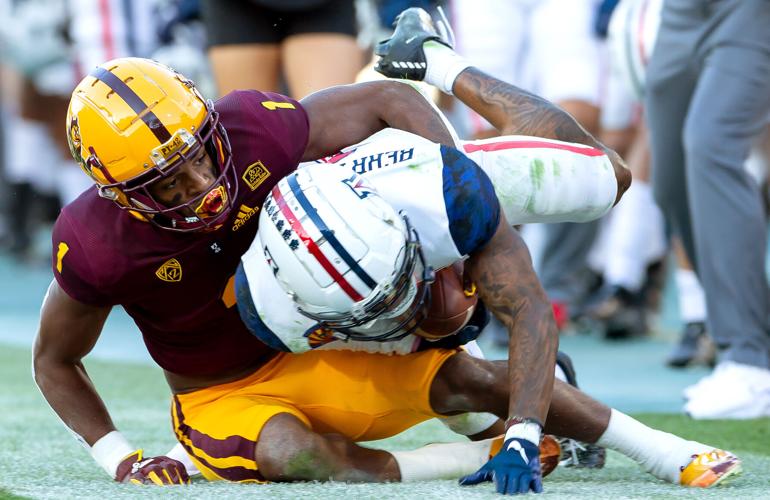At 7:45 Saturday evening, the lights on an SUV labeled “State Trooper’’ began to flash on Interstate 10, just outside the Casa Grande city limits. Everyone slowed to 65 mph, staying a safe distance behind the trooper.
Caught in a mix of traffic, I chuckled at the timing of the slowdown. It was almost immediately next to the “No Pity for the Kitty’’ billboard erected a year earlier by ASU football fans.
It didn’t take long for an intrepid super-sized pickup driver to speed up to 75 mph and pass the state trooper. Everyone soon followed.
Why the slowdown?
The state trooper was one of three such vehicles escorting an 18-wheeler and five large buses filled with Arizona football players, coaches, donors, administrators and a cargo of grass-stained football uniforms headed south to Tucson.
It seemed so excessive and out of place. With lights flashing, was it necessary for state troopers to escort the only 1-11 Power 5 football team in America back to campus? Why all the fuss and expense?
This wasn’t 11-1 Alabama‘s ebullient Saturday night procession to Tuscaloosa on Interstate 85, returning from a triumphant four-overtime victory against hated rival Auburn.
It reminded me of an October afternoon in 2002, when, driving to a hotel near the San Francisco airport in advance of the next day’s Arizona football game, I was forced to veer to an outside lane to make way for a police escort in front of three buses.
It was the UA football team, coached by John Mackovic, a team that would finish 1-7 in the Pac-10, last place, tied with the next day’s foe, Stanford, which beat Arizona 16-6 a day later.
Today as yesterday, win or lose, the show goes on in college football, be it 1-11 or 11-1.
Arizona completed its football season with its fewest victories since 1957 and its lowest home attendance since 1972. Jedd Fisch’s first Arizona squad probably led the NCAA in one category: trick plays (most of them unsuccessful). About the only reason the UA had to celebrate anything is that it is now off the hook for $800,000 paid to former defensive coordinator Paul Rhoads and $600,000 to former offensive coordinator Noel Mazzone, both a big part of the reason Fisch inherited a winless team.

Jedd Fisch had a rough first season in Tucson, but the 1-11 year will be forgotten if he can find success on the recruiting trail.
This isn’t meant as a doomsday forecast for Arizona’s football program. It is worse elsewhere. Even without its COVID-19-affected victory over a depleted Cal team, the Wildcats had a better season than the Texas Longhorns, who averaged 91,961 fans at Darrell Royal Stadium.
The Longhorns lost six straight and are not bowl eligible. Their “home run’’ coaching hire, Steve Sarkisian, who inherited a load of big-name players, came off as ineffective as he was at USC and Washington.
There are many different versions of failure in college football. Arizona probably improved more than the Longhorns this season. Texas gave former Washington defensive coordinator Pete Kwiatkowski a three-year contract for a sum of $5.1 million. Kwiatkowski’s Longhorns allowed more yards per game (427 to 373) than Arizona.
This “No Pity for the Kitty’’ stuff isn’t limited to one school.
Conversely, there are many different versions of victory in college football. Despite being part of a 1-11 season, Arizona defensive coordinator Don Brown, who appeared to be a beloved figure on campus and in the locker room, received $1.7 million in total compensation: $1.2 million from his former employer, Michigan, and $500,000 from Arizona.
Brown used his season in the sunshine to earn a trip back home, as the head coach at UMass, which is 23 miles from his hometown and within an hour’s drive of each of his four kids and 11 grandchildren.
This was a winning season for Don Brown, who became a UMass Minuteman the moment Arizona lost the Territorial Cup for a fifth consecutive season.
Things can change so quickly in college football that it wouldn’t be a shock if Fisch out-performs ASU’s Herm Edwards next season and hoists the Territorial Cup in a long-awaited Arizona Stadium celebration. Or if Edwards, whose program is under investigation for recruiting irregularities, is even ASU’s coach at next year’s Territorial Cup.
The offseason is right down Fisch’s football alley. He’s diligent, engaging and persistent in delivering a sales pitch. I wouldn’t want to recruit against him. No one is more organized and determined.
The next two weeks are Fisch’s chance to win a few that won’t be posted on the scoreboard until 2022 or later.
So much changes so quickly in college football. For example: Fisch had a much better season than the 2020 AFCA coach of the year, Indiana’s Tom Allen.
A year ago, Allen led the Hoosiers a sweep over Michigan and Michigan State as Indiana finished No. 12 in the AP poll. This year the Hoosiers went 0-9 in the Big Ten. They averaged just 10 points a game in the conference. Everything imploded at Indiana this season the way they imploded at Big Boy Pac-12 programs USC, Washington and Stanford.
Indiana got so carried away by its success of 2020 that it gave offensive coordinator Nick Sheridan a raise to $950,000 a year. Last week the school fired Sheridan and made the rare move of taking that money out of Allen’s future paychecks.
Last week, the-cellar dwelling Hoosiers were throttled 44-7 at rival Purdue. Their 120-mile drive home on Interstate 65 must have been as quiet as Arizona’s five-bus entourage from Tempe.
The stuck-in-traffic feeling comes and goes in college football. Those state troopers know well the late-night route to Sun Devil Stadium, too.






